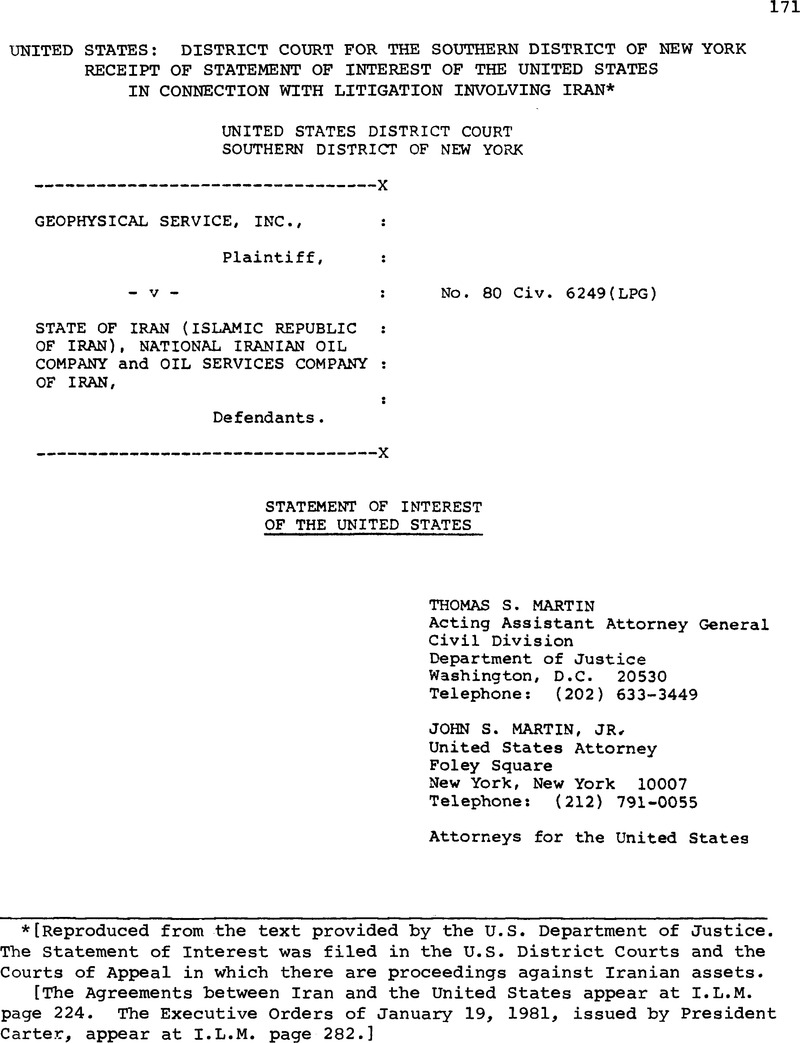No CrossRef data available.
Article contents
United States: District Court for the Southern District of New York Receipt of Statement of Interest of the United States in Connection with Litigation Involving Iran*
Published online by Cambridge University Press: 04 April 2017
Abstract

- Type
- Judicial and Similar Proceedings
- Information
- Copyright
- Copyright © American Society of International Law 1981
Footnotes
[Reproduced from the text provided by the U.S. Department of Justice. The Statement of Interest was filed in the U.S. District Courts and theCourts of Appeal in which there are proceedings against Iranian assets.
[The Agreements between Iran and the United States appear at I.L.M.page 224. The Executive Orders of January 19, 1981, issued by President Carter, appear at I.L.M. page 282.]
References
1 / The Secretary's declaration, attached hereto, outlines the full terms of the United States' agreement with Iran.
2 / Several claimants have obtained injunctions which arefunctionally equivalent to attachments, and for purposes of this document the term attachment is intended to incorporatethose equivalent injunctions.
2 / IEEPA's principal operative provision, 1702(a)(1), providesthat when a national emergency has been declared the President may:
(A) investigate, regulate or prohibit — (i) any transactions in foreign exchange, (ii) transfers of credit or payments between, by, through, or to any banking, institution, to the extent that suchtransfers or payments involve any interest of any foreign country or a national thereof, (iii) the importing or exporting of currencyor securities; and (B) investigate, regulate, direct and compel,nullify, void, prevent or prohibit, any acquisition, holding, withholding, use, transfer,withdrawal, transportation, importation or exportation of, or dealing in, or exercisingany right, power, or privilege with respect to, or transactions involving, anyproperty in which any foreign country or a national thereof has any interest ….
4 / The identical language of section 5(b) of the TradingWith the Enemy Act had been interpreted as providing the Executive that authority. See, e.g., Propper v. Clark, 337U.S. 472, 484-486 (1949); SlrcTino v. Federal Reserve Board, 361 F.2d 106 C2d Cir. 1966); Nielsen v. Secretary of Treasury,424 F.2d 833, 839 (D.C. Cir. 1970).
5 / These regulations were authorized by the power to “regulate * * * any transfer * * * of,” Iranian assets, and the authorityto “regulate * * * [or] prevent or prohibit * * * [the] exercising [of] any right, power or privilege with respect to”Iranian property. 50 U.S.C. 1702(a)(1)(B). *[See I.L.M. page 282.]
6 /The provisions of IEEPA were modeled after the TWEA and interpretations of that Act are directly applicable to IEEPA.See H. Rep. No. 95-459, 95th Cong., 1st Sess. 14-15 (1977).
7 / Bank Markazi's immunity from attachment has not been waived Ey any pre-existing agreement within the terms of 28 U.S.C. 1609.See New England Merchants Nat. Bank v. Iran Power Generation £ Transmission Co., supra; E-Systems, Inc. v. Islamic Republicof Iran, CA-3r79-1487-G (N.D. Tex. June 19, 1980), and Reading & B*tes Corp. v. National Iranian Oil Co., 478 F.Supp 72~4”Ts.D. N.Y. 1979), contra, Behring Int’l, Inc. v. Imperial Iranian Air Force, 475 F.Supp. 383 (D. N.J. 1979).In his September 26, 1980 opinion and order confirming attachments in New England Merchants National Bank v. IranPower Generation and Transmission Co., 79 Civ. 6380 (S.D. N.Y., Sept. 26, 1980) , Judge Duffy concluded that the Iranianassets would be immune from attachment on sovereign immunity grounds but for Executive Order 12170, which he viewed as“suspending” that immunity. Apart from the Executive Order “freezing” the assets, Judge Duffy found no legal basis toconclude that Iran had waived or otherwise was not entitled to immunity from pre-judgment attachment. Slip Op. pp. 8-17,21-24.Assuming, arguendo, that Judge Duffy's analysis of the effect of the blocking order on Iran's sovereign immunitywas correct, the newly promulgated Executive Order restored Iran's incidents of sovereignty (namely the ability to fullydeal with its assets) upon the return of the hostages and the attachments became invalid as a matter of law.
8 / Indeed, IEEPA specifically provides that “no personshall be held liable in any court * * * for anything done oromitted in good faith in connection with the administration of, or pursuant to and in reliance on, [IEEPA] or any regulation, instruction, or direction issued under [IEEPA],” 50 U.S.C. 1702 (a)(3), in order to insure that those subject toa Presidential directive may immediately comply with that directive without fear of liability for those actions.
* [See I.L.M. page 287.]
* [See I.L.M. page 282.]
* [See I.L.M. page 225.]




